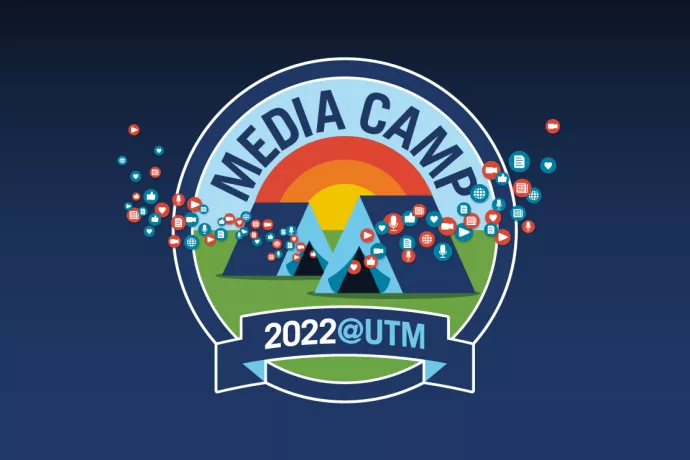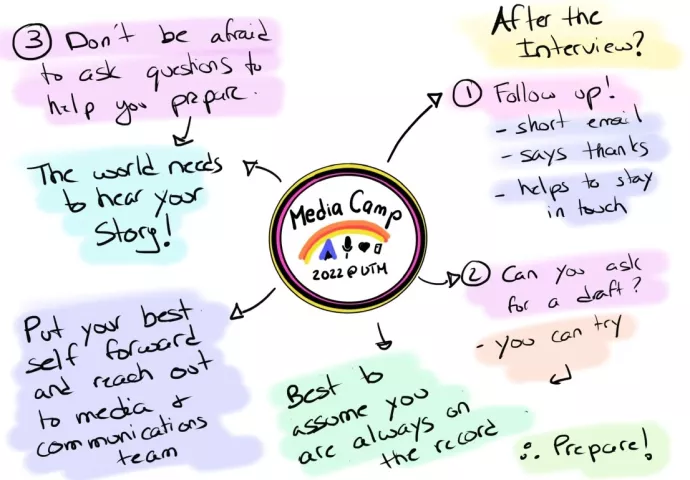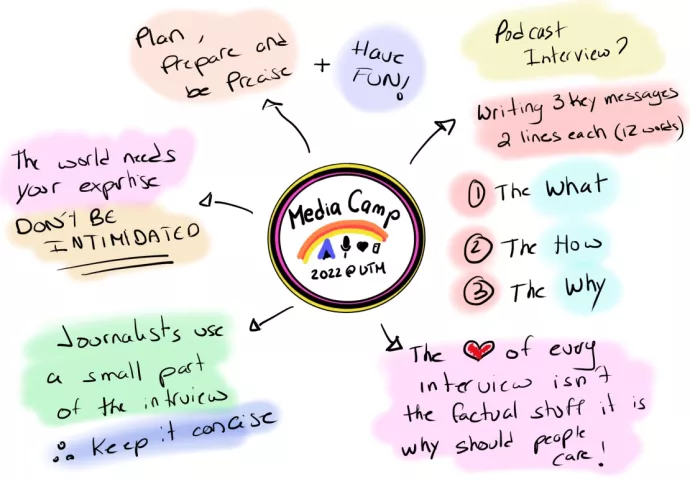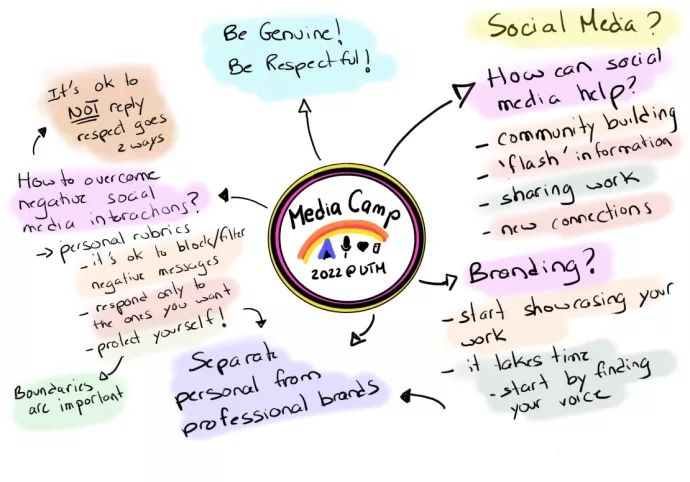
“Don’t be intimidated”: Tips and takeaways from UTM’s first Media Camp
Journalists are eager to hear from researchers, Media Camp attendees heard during a two-day professional development event that brought journalists and media experts together with hundreds of researchers from U of T Mississauga and across U of T.
The 2022 event, which was also attended by communications staff and librarians, was inspired by an event organized last year by Temerty Faculty of Medicine and the School of Cities.
Several themes emerged during the sessions, which delved into topics such as podcasting, writing op-eds, social media branding and interviewing.
Among the themes: Don’t be intimidated! While it might initially be outside your comfort zone, researchers should remember they are a rare and valuable commodity – especially to journalists who seek expert voices to give their news coverage context and meaning.
Another theme: Supports are in place for researchers who want to work with the media. U of T Media Relations director Philippe Devos notes that the media relations team is just an email away, while Nicolle Wahl, acting executive director of UTM’s Office of Communications, adds that her growing team is available to help UTM researchers.
The recently launched EDIO equity hub is another place to find support on a range of topics including digital safety when doing media work.
Here are a few Media Camp ’22 tips and takeaways:
-
Get the request in writing. When dealing with a request from the media, ask for an email that summarizes the request and other key info.
-
Find the sweet spot. Take some time to figure out where your expertise and the journalist’s request intersect.
-
Don't write out a script. Instead, review your research, write down three key messages, memorize those and then speak from the heart – and your experience.
-
Making a mind map with a few key phrases could be helpful to jog your memory, advises Informed Opinions director Shari Graydon.
-
Set boundaries: A 10-minute time limit on interviews helps to ensure that you stay on message and protects your valuable time, notes Graydon.
-
Know that in most cases, only a small fraction of the interview will make it to the final product, advise CBC News journalists Chris Glover and Ali Raza. A short interview focused on key messages helps ensure that the important info gets across.
-
You can ask to see a draft of the story before publication, but don’t hold your breath. Most news outlets have a policy against giving sources a preview.
-
If you can, strive to distill your information down to short, digestible soundbites. These can be incredibly helpful when explaining complex concepts to a layperson, Raza says.
-
Be fast. CityNews Toronto journalist Maleeha Sheikh notes that a quick response, even if it is to decline the request, is appreciated in the fast-paced world of breaking news.

-
When it comes to pitching opinion pieces and editorials, think about why this is significant right now. Vinita Srivastava, a senior editor at The Conversation, advises that timing is crucial and notes that opinion pieces are more likely to be published if they dovetail with events and issues currently in the news.
-
Key ingredients for a successful op-ed: it’s relatable and analytical. It should also be topical and based on new research, even if it’s still preliminary.
-
Keep it short, simple and accessible. Media relations experts Gabrielle Giroday, Ravisha Mall and Jessica Boafo advise to aim for a Grade 9 reading level.
-
Complex data and concepts are often better as a visualization, Globe and Mail data journalist Chen Wang notes. If readers might get bogged down by a densely written paragraph, maybe a visualization is better.
-
Collaborations between researchers and journalists can be very successful, says Wang. For example, this New York Times interactive project on California’s Dixie fire was inspired in part by data visuals tweeted by a professor of meteorology.
-
Play to your strengths, says anthropology assistant professor Madeleine Mant, a self-described “theatre kid” who uses her extensive collection of historical costumes and props to illustrate public health milestones.
-
Know that data visualization takes time and resources to create. Biomedical Communications director Jodie Jenkinson notes there are free and relatively easy tools available including Datawrapper.
-
Podcasting is the “ultimate knowledge translation experience,” says management professor and For the Love of Work podcast host Sonia Kang. Podcasts create a narrative to teach people the most important parts of a topic.
-
Remember that podcasting is all about storytelling, says Pacific Content showrunner Mio Adilman. "Tell me a story about how you arrived at your conclusion or your discovery." People relate well to the warm and personal nature of the audio format.
- Don’t worry about the metrics, says Carla DeMarco, producer and host of UTM’s research-focused View to the U podcast. Instead, think of the podcast as an archive and oral history of your work.

- However much you might want to, don't engage in arguments on social media or in the comments, advises Institute of Communication, Culture, Information and Technology (ICCIT) associate professor Bree McEwan. Don't give credence to trolls or other individuals who only want to incite a reaction.
-
Follow up with offers to fact-check: You absolutely can and should offer to fact-check aspects of your research, especially if it’s complex or easy for someone without deep knowledge to get wrong.
-
Branding: While researchers don't necessarily need a public brand, it can be useful to think about what one or two words you'd like people to associate with you and your work. For professors Fiona Rawle, Jordana Garbati and Marius Zoican, those words included "genuine," "helpful" and "go-to expert,” respectively.
-
When dealing with online harassment, use the tools at your disposal. Block the trolls and mute topics or individuals that you find distracting or damaging.
-
Ask yourself, what would I do in a real-life situation? If you would walk away from a hostile conversation, do the digital equivalent, advises Garbati.
-
While social media can be a great way to create meaningful connections, panelists from the Social Media & the Public Eye session agreed that it's necessary to separate personal and private. For example, a researcher may have a public Twitter profile but a private Instagram account.

Illustration by U of T research associate Maria Abou Chakra. -
Visibility is crucial. Journalists actively seek voices and perspectives from communities historically underrepresented in the news, notes Tamika Forrester, who is the senior producer of CBC’s Being Black in Canada.
-
If you’re trying to do more media work, set an annual goal, advises ICCIT assistant professor Dan Guadagnolo. After you reach it, feel free to turn your attention to other priorities.
-
Never underestimate the power of television. ICCIT lecturer Daniel Tsai says he seems to get noticed more for a short TV news appearance than for regular print columns.
-
Push versus pull: Shauna Brail, associate professor of urban innovation, notes some researchers proactively push their research out into the world, while others are pulled in by requests when their research coincides with current events.
Interested in exploring media work? U of T media relations and communications teams have the connections and resources to help land your research in the headlines.
Resources:
- U of T Social Media Guidelines
- Tips for UTM researchers on sharing your work
- How to write opinion pieces that get noticed
- Register for May 27 session on writing Op-Eds
- Sign up for the U of T Blue Book of media experts
- Join the database for Informed Opinions, which amplifies the voices of women and gender-diverse people
- Become an author for The Conversation to get started as an Op-Ed writer
- Pitch guidelines from Rebecca Onion at Slate
- UTM Library audio & video resources
- Transom podcasting tips and training
- UTM Library guide to setting up a faculty website
With contributions from Blake Eligh, Carla DeMarco, Heather Hines and Elizabeth Parke
